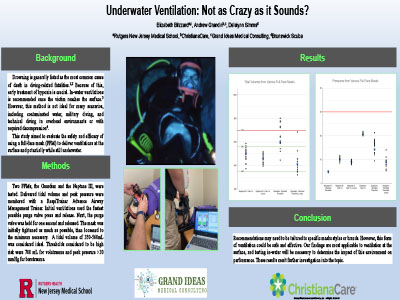ABSTRACTS
Underwater Ventilation: Not as Crazy as It Sounds?Author: Elizabeth Blizzard and Andrew Grandin | | Associate Authors:
Introduction: Early oxygenation is essential in SCUBA diving–related hypoxia, but the need to exclude water makes underwater ventilation challenging. The full-face mask (FFM) is a potential solution, but its safety and feasibility have not been established. Objective: To evaluate the utility of FFMs for underwater ventilation. Methods: Two FFMs, the Guardian and the Neptune III, were tested. Delivered tidal volume and peak pressure were monitored with a RespiTrainer Advance Airway Management Trainer. The FFM was applied to the manikin head and connected to a standard SCUBA tank. All ventilations were delivered by the same person. Initial ventilations used the fastest possible purge-valve press and release. Next, the purge valve was held for 1 second and released. The mask was initially tightened as much as possible, then loosened to the minimum necessary to remove gaps in the seal, as overtightening is discouraged by manufacturers. A tidal volume of 350–560 mL was considered ideal. Thresholds considered to be high risk were 700 mL for volutrauma and peak pressure > 30 mm Hg for barotrauma. Results: In all trials, the delivered pressure remained well below the 30 mm Hg threshold. Both masks were capable of staying below the dangerous volume threshold. For the Neptune 3, a 1-second depression of the purge valve was found to be sufficient, but the volume never exceeded 700 mL. The Guardian delivered at least one ventilation exceeding the threshold unless the purge was released as quickly as possible and the mask not maximally tightened. However, 25% of ventilations were below the 350-mL minimum in this trial. Conclusion: Recommendations need to be tailored to specific mask styles or brands. However, this form of ventilation could be safe and effective. Our findings are most applicable to ventilation at the surface, which could be particularly useful in rough or contaminated water and resource-limited environments. Underwater ventilation would be especially useful in environments where surfacing is delayed (overhead, decompression, or military diving), but testing in water will be necessary to determine the impact of this environment on performance. These results merit further investigation into the topic.
|

